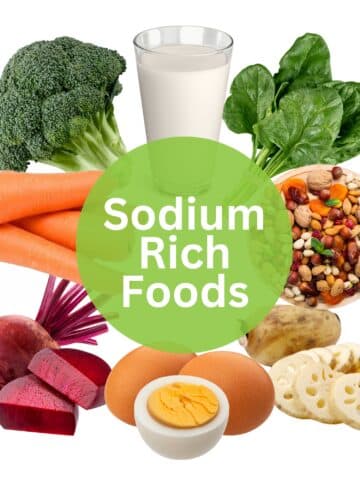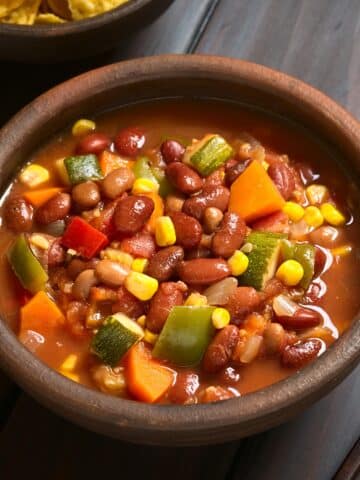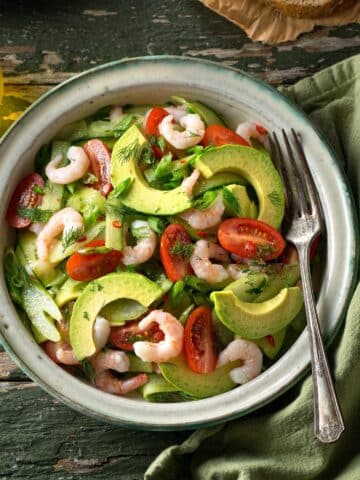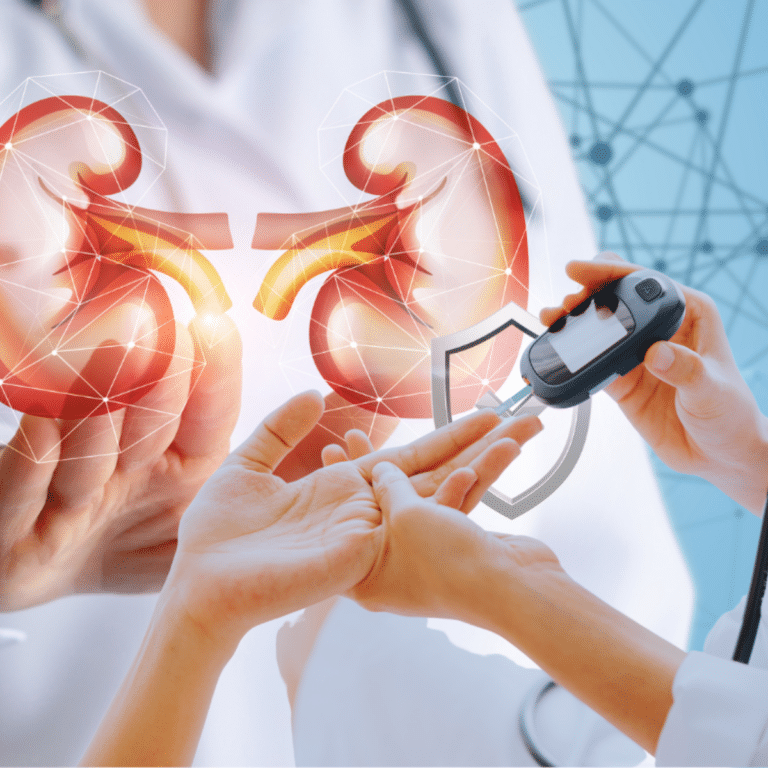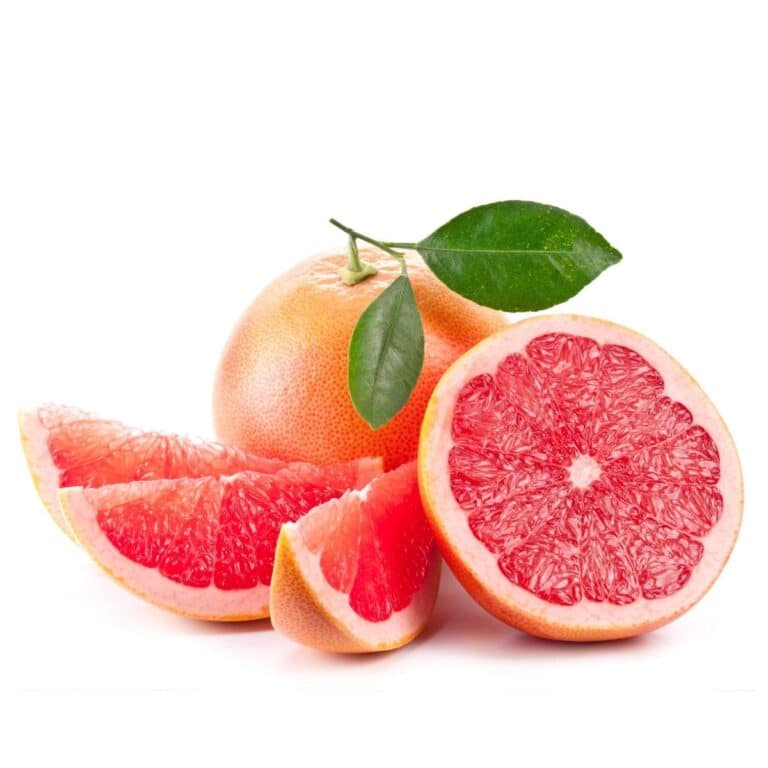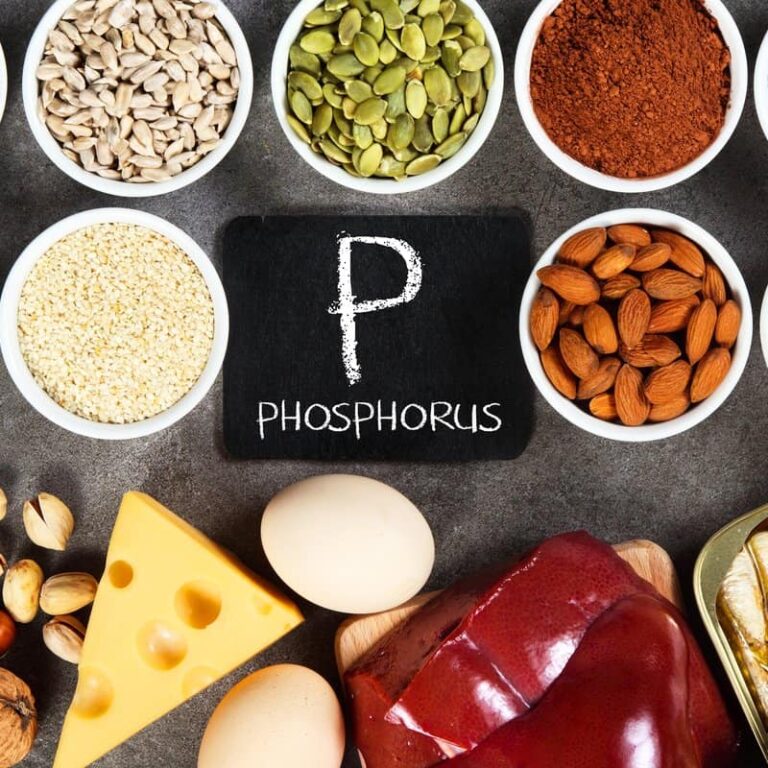Renal Diabetic Diet Sample Menu
For adults with diabetes and chronic kidney disease, the importance of providing meal plans that meet their needs cannot be overstated.
Eating healthy doesn’t have to be boring; it can include nutritious, delicious meals that will help you control your blood sugar levels and preserve your kidney function. You can also take a peek at this kidney friendly diet for diabetics.
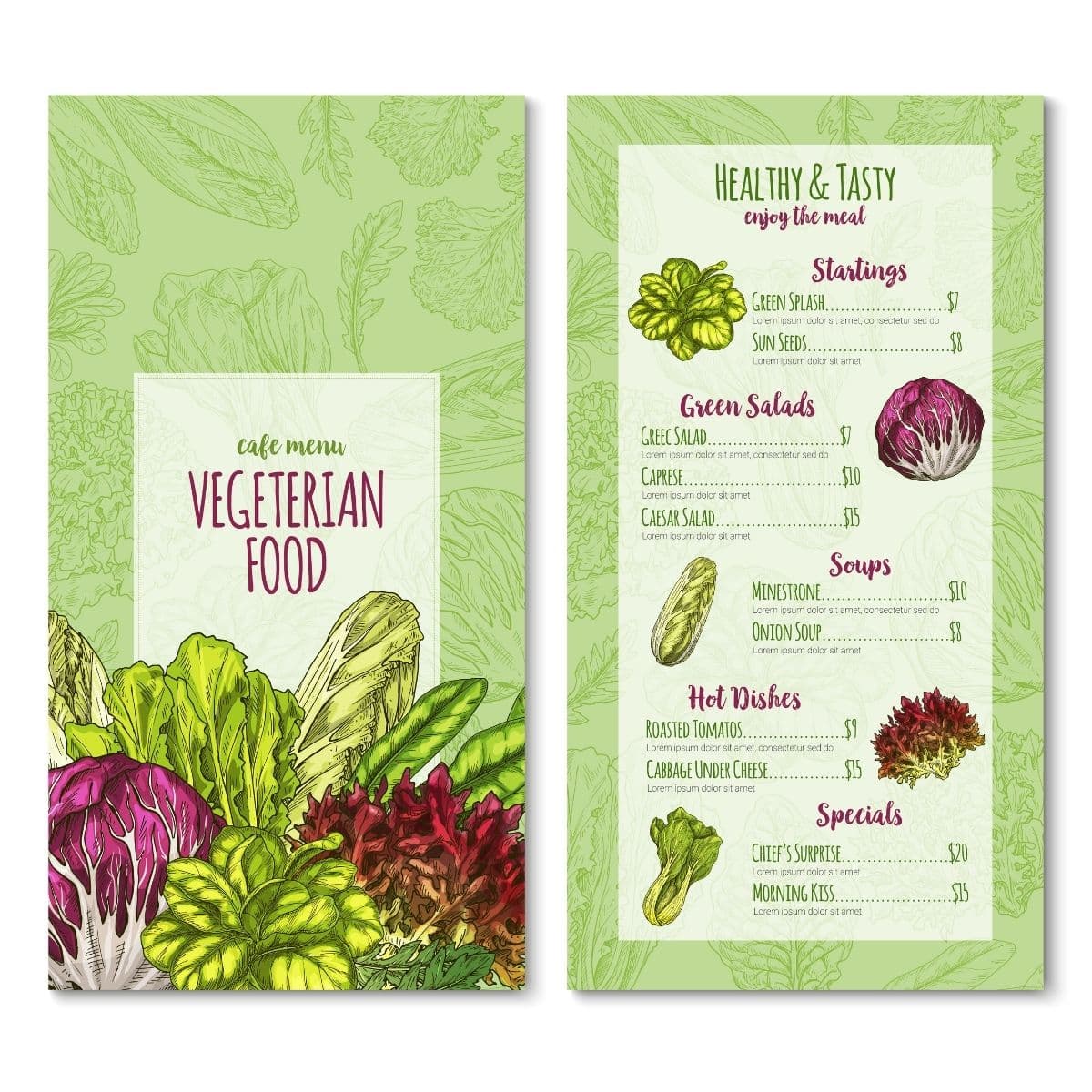
In this article, we'll look at a renal diabetes diet sample menu. Whether you are living with both conditions or just one, this sample menu is sure to make life easier by giving you ideas for tasty meals that cater to your needs due to your medical condition.
Jump to:
- What Is A Renal Diabetic Diet?
- Foods To Include
- Foods To Avoid In A Renal Diabetic Diet
- Benefits Of A Renal Diabetic Diet
- How To Create A Meal Plan
- Nutritional Considerations
- Tips For Eating Out
- Sample Menu For A Renal Diabetic Diet
- Tips When Creating Menus
- Monitoring Your Progress
- FAQs for Renal Diet Diabetic Sample Menu Ideas
- A Renal Diabetic Diet Is Complicated - But Worth It!
What Is A Renal Diabetic Diet?
A renal diabetic diet is a diet that takes the nutritional, general dietary, and other restrictions of the renal diet and the diabetic diet and puts them into one. So, essentially, this type of diet is the perfect thing for those who are diabetic and people with kidney disease.
This type of kidney diet will take into account low carbs, low sugar, low sodium, low potassium, and other restrictions and adjustments that are characteristic of both diets. If you have both diabetes and kidney disease, a diabetic kidney disease diet is a very important part of the usual care plan.
Anyone can use this diet and these diet plan samples if they want to, but those who benefit the most from it are individuals who have diabetes and who deal with chronic kidney disease.
While this is not a dialysis-specific diet, many of the recipe examples and the diet itself could still be beneficial to show recipes for dialysis patients with diabetes, with a few adjustments and watchfulness of liquid intake.
The benefits of this diet include improved control of blood sugar and reducing the risk of progression of kidney disease. A renal diabetic diet can help you manage your weight and ensure you get enough essential nutrients.
When following this diet, it is important to eat regularly, choose lower-sodium foods and eat more plant-based proteins. You can make amazing meals like these low sodium spaghetti squash recipes.
Lastly, be sure to talk to your healthcare provider or a registered dietitian nutritionist (RDN) to ensure you are meeting your nutritional needs.
For More Recipes and Ideas --->> Get Your Free Meals and Recipes That Are Perfect for Pre-Dialysis Diets, Pre-Dialysis with Diabetes, or Dialysis Diets.
Foods To Avoid
It is important to remember that when following a renal diabetic diet, there are certain foods which should be avoided. High potassium foods, foods with lots simple sugars such as sugared sodas.
Processed foods like corned beef or luncheon meat and other foods with high sodium content should be avoided in a kidney disease meal plan.
Furthermore, managing portion control for diabetics and for CKD patients and reading nutrition facts can help ensure that their dietary choices align with their nutrition needs.
Ultimately, these steps taken together offer a powerful combination for effectively managing the impacts of both diabetes and kidney disease (renal diet food list) on one's renal health and overall wellbeing as well.
Benefits Of The Diet
Following a renal diabetic diet provides numerous benefits to those who adhere to it. It should emphasize the importance of preventing complications by monitoring glucose levels and managing stress through mindful eating techniques such as taking time to eat, rather than rushing meals.
Adhering to this diet also helps avoid cravings caused by consuming too many processed foods and added sugars. Moreover, having balanced meals with plenty of fruits and vegetables will help boost energy throughout the day.
All in all, following a renal diabetic diet is key for achieving optimal health outcomes while living with diabetes or kidney disease.
Eating Tips
When it comes to following a renal diabetic diet, portion sizes are key. It is best to pay close attention to nutrition labels when grocery shopping. This helps ensure you're aware of the number of carbs, calories, and other nutrients in each food item purchased.
Eating healthy snacks such as fruits and nuts throughout the day can also help manage glucose levels while providing nutrition.
Meal prepping is another great way to keep track of calorie intake and make sure meals are balanced with protein, carbohydrates, heart-healthy fats, and fiber. There are also heart healthy lifestyle changes for CKD that you can make.
All these tips are important for those looking to adhere to a renal diabetic diet—a lifestyle change that will lead to improved health outcomes over time!
Foods To Include
For a diabetic kidney disease meal plan, it's important to include a variety of high-fiber foods like legumes, whole grains, and vegetables. These foods help to keep blood sugar levels stable and provide healthy sources of energy.
For sodium control, it's best to keep avoiding highly processed foods and opting for low-sodium options like fresh fruits and vegetables.
Additionally, be sure to include lean proteins such as poultry and fish, as they will provide essential amino acids needed for optimal functioning. Curious about What fish is good for kidneys? I am happy to share that information with you!
High-Fiber Foods
Fiber rich snacks like fruits, vegetables, legumes and nuts can improve overall health while also helping manage blood sugar levels.
Furthermore, portion controlled meals and meal prepping strategies that incorporate kidney friendly recipes with healthy fats will not only provide essential nutrients but also keep them feeling full throughout the day.
With these tips in mind, people with renal disease and diabetes are sure to have a balanced diet that meets all their needs!
Low-Sodium Foods
In addition to fiber rich foods, it's important for people with renal diabetes to focus on low-sodium options. Sodium intake can be managed through salt substitutes like herbs and spices or even just using less table salt when cooking meals at home.
Keeping an eye on potassium levels is also key as too much sodium in combination with high levels of potassium can cause serious health problems.
Try healthy snacks that are naturally low in sodium such as raw vegetables, unsalted crackers, nuts, and seeds, fresh fruits, and whole grains.
Salads offer another excellent choice, allowing for a variety of vegetables paired with a low-salt dressing. To satisfy the sweet tooth, a fruit platter provides a delicious snack without the additional salt, and it can be complemented with a healthier yogurt dip.
By focusing on these tips, you will not only keep your blood sugar stable but also ensure they're getting the right balance of minerals essential for good health.

Foods To Avoid In A Renal Diabetic Diet
It is recommended to avoid high sodium foods on a renal diabetic diet. This includes processed meats, canned soups and sauces, and snack foods.
Processed foods can be high in fat, salt, and sugar, so it's best to avoid them when following a pre-dialysis renal diet.
Sugary foods, such as candy, cake, and cookies, should also be avoided as they can cause blood sugar spikes.
This is especially important for those with renal disease, as their bodies may have difficulty regulating sugar levels. Focus on eating healthier sources of carbohydrates, like whole grains, fruits, and vegetables.
High Sodium Foods
It can be important to advise a renal diabetic patient about sodium intake due to the kidney's inability to regulate salt. High levels of sodium in one's diet can put them at risk for further health complications and therefore should be avoided when possible.
Some high-sodium foods that one should stay away from are processed meats, canned soups, pickled vegetables, and sauces such as soy sauce or teriyaki marinade.
As an alternative, there are many low-sodium options available like fresh fruits and veggies, unsalted nuts and seeds and cooking from scratch using herbs, spices and salt substitutes.
It is also beneficial to read food labels closely so that you know exactly how much sodium you're consuming - this will help keep your sodium levels within the recommended range.
Ultimately, by understanding what sources of sodium to avoid within your kidney disease meal plan, you'll make healthier choices for yourself on a daily basis!
Processed Foods
Processed foods (and CKD) are a common source of sodium, as well as unhealthy fats, refined sugars, and artificial additives. It is best to avoid processed foods for renal diabetic patients due to their high content of these harmful ingredients.
Labeling regulations can be confusing when it comes to serving size, so better read them closely before deciding what to purchase. It's also important to remember that most processed products contain little to no healthy oils or vitamins. Instead they're usually filled with preservatives, added sugar and other artificial flavors.
In order to get the nutrients your body needs without consuming too much salt, look for wholesome options like fresh fruits and vegetables which don't have any hidden ingredients!
To ensure you eat in moderation and stay within dietary guidelines, opt for smaller portions of natural whole foods that are free from refined sugars or unnatural additives.
Sugary Foods
When it comes to a renal diabetic diet, sugary foods are something that should be avoided. Try sugar free substitutes like artificial sweeteners or stevia for those who struggle with sugar cravings. As always, these kinds of sweetener should be consumed in moderation.
Consuming too much sugar can cause spikes in blood glucose levels which can lead to serious health consequences. To avoid these dangerous effects and still satisfy your sweet tooth without the added risk of high sugar intake, opt for natural sugars such as honey, maple syrup or dates instead.
In small amounts, instead of sugary fruit-flavored drinks, opt for fresh low-potassium fruit juices with no added sugar for a refreshing drink.
Making small changes to your dietary habits is key when it comes to managing diabetes and reducing sugar consumption is one way you can reduce your overall risk of developing related complications down the line.
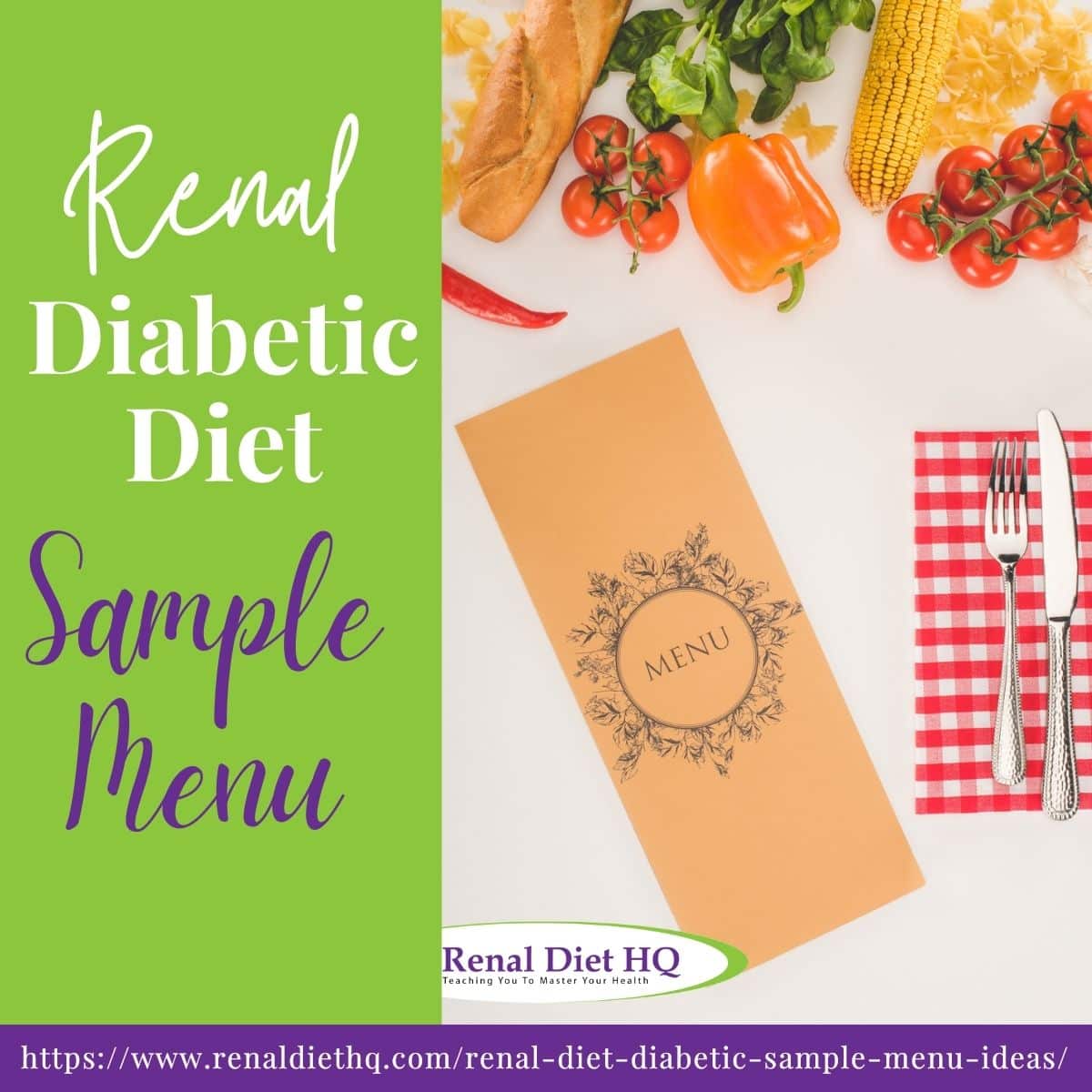
Benefits Of A Renal Diabetic Diet
A renal diabetic diet is great in helping manage blood sugar levels and improve heart health. This diet reduces carbohydrates and sugar, while increasing protein and healthy fats to reduce sugar spikes.
It also reduces sodium and increases dietary fiber intake, which may help control blood pressure as well as cholesterol.
Can kidney disease cause heart problems? By following a kidney diet for diabetics and making healthy food choices, blood sugar levels and heart health can both be improved.
Lower Blood Sugar Levels
By understanding the power of nutrition, reducing inflammation, managing stress, avoiding complications, and monitoring progress – it is possible to maintain healthy glucose levels while living with renal failure.
For example, incorporating vegetarian proteins such as lentils or quinoa into meals can provide efficient energy without spiking blood sugars too high; adding omega-3 fats like salmon will help reduce inflammation in the body; and opting for foods that are low glycemic index can all help to stabilize your glucose levels.
Taking these steps towards better health may lead to improved quality of life and long-term benefits that can be seen through regular checkups with your healthcare team.
Improved Heart Health
Making sure your diet is tailored to fit the needs of those with renal failure can also have positive impacts on heart health. Eating a balanced diet that reduces inflammation and helps control weight, along with stress management and physical activity, are key components for keeping our hearts healthy and strong.
Incorporating anti-inflammatory foods such as leafy vegetables (like spinach and kale) and fatty fish (like mackerel and tuna) into meals can help reduce inflammation; eating more whole grains which provide energy while keeping blood sugar steady; and avoiding processed or fried foods will all contribute towards better cardiovascular health.
A healthy diet combined with regular checkups with healthcare professionals can help us keep an eye out for any early signs of disease progression or risk factors associated with poor heart health.
How To Create A Meal Plan
When creating a meal plan, it's important to consider planning, shopping, portion control, and nutrition balance. Variety, calorie counting, and eating habits are also important factors to consider, as well as budgeting, dietary restrictions, and seasonal foods.
For an optimal meal plan, include meal prep, leftovers, food groups, superfoods, and labels. Expertise from a registered renal dietitian can also help you create a meal plan that works best for you and your lifestyle.
Planning
Creating a meal plan that is tailored to the needs of a diabetes patients with kidney disease can be daunting.
Meal planning should focus on portion control and blood sugar management. Incorporating foods that are low in sodium and reading food labels for potential hidden sugars or added fats will provide essential guidance as well.
Do research regarding kidney-friendly recipes that are also suitable for diabetes management. In this way, you’ll have a menu prepared for the week and you will know which ingredients to buy during your grocery trip.
Planning meals ahead of time helps ensure you're getting all the nutrients your body needs - such as calcium, iron, magnesium, vitamin D and zinc- while managing your blood sugar levels.
Preparing snacks ahead of time so they’re ready when hunger strikes is also important for keeping your glucose levels balanced throughout the day.
With thoughtful meal planning you'll have more energy and feel better overall! You can even check out this 7 day renal diet meal plan for free!
Shopping
Shopping for the right foods to create a meal plan can be difficult, but with some preparation it doesn't have to be. One of the best prepping tips is making a list before heading out.
Budgeting techniques are also essential when shopping on a diabetes-friendly diet. You can also view this Comprehensive Healthy Renal Diet Grocery List Guide to help you with your shopping.
When you’re at the store, make sure to read food labels closely so that hidden sugars or added fats don't sneak into your cart! If necessary, dietary supplements like calcium and vitamin D can also help fill in any nutrient gaps, but be sure to check with your doctor first.
Additionally, portion control is key so try not to over buy perishable items if possible. With these guidelines in mind, you'll be able to shop confidently knowing that you're getting all the nutrients your body needs while managing blood sugar levels and staying within your budget.
Nutritional Considerations
It's important to consider a number of nutritional components when creating a renal diabetic diet menu. Fiber, carbs, sodium, protein, potassium, calcium, magnesium, iron, vitamins, fats, hydration, blood sugar, cholesterol, omega-3s, and omega-6s are all key elements that should be taken into account.
It is wise to include foods that are rich in fiber, low in carbohydrates and sodium, high in healthy proteins, and contain plenty of calcium and magnesium.
Additionally, incorporating foods with vitamins, healthy fats, and adequate hydration can help keep blood sugar and cholesterol levels in check. Finally, adding foods that are rich in omega-3s and omega-6s can help to ensure a balanced and healthy diet.
Fiber
It is important to consider the amount of fiber in your renal diabetic diet. Add high-fiber foods such as legumes, whole grain foods, fruits and vegetables, nuts, and seeds into your. Whole-grain breads, bran cereals, and brown rice are other sources of fiber that also provide healthy carbs.
Aim for a minimum of 25 grams of dietary fiber per day and be sure to check labels for serving sizes when selecting gluten free products.
Additionally, eating food with a higher fiber content can help improve blood sugar control by slowing digestion and absorption of carbohydrates. Eating more plant-based proteins like beans or lentils can also aid in digestion.
Ultimately, increasing the intake of dietary fiber will not only provide essential nutrients but also promote satiety which may support weight management goals.
Carbs
When it comes to nutritional considerations for people with renal diabetes, carbohydrates are also an important component. Practice portion control and focusing on carb sources that are low in glycemic index such as non-starchy vegetables, whole grains and legumes.
Additionally, meal timing is key; having smaller portions of carbs at each meal can help maintain better blood sugar levels throughout the day.
Carb counting may be a helpful strategy for those who need more precise tracking but always aim to focus on nutrient dense foods and choose healthy sources of carbohydrates like oats or quinoa over processed snacks like chips or candy bars. However, there is lots of kidney friendly candy out there.
Sodium
When it comes to managing sodium for those with renal diabetes, reducing sodium intake to less than 2000 milligrams per day is important. It is ideal to track how much salt is being consumed by measuring and reading labels.
Another helpful tip is looking for salt substitutes like herbs or spices when cooking at home to help add flavor without excess adding table salt. Reducing daily sodium consumption can help maintain better blood pressure levels over time.
Additionally, it's important to remember that many processed foods are high in added salt so choosing whole food sources whenever possible is one of the most effective ways to manage our sodium intake.
Tips For Eating Out
When eating out, it's important to order smaller portions to maintain proper blood sugar control. Ask your server if they can provide a substitution, such as a side of mixed vegetables instead of a starchy or salty side dish like potato chips.
Also, don't be afraid to ask the chef to prepare your entrée without added sugar, salt, or fat. Making small changes like these can help you manage your renal diabetic diet and still enjoy eating out. When you want more tips for dining out with kidney disease, keep following this blog.
Order Smaller Portions
Ordering smaller portions is one of the best tips for eating out. This is because when it comes to maintaining dietary restrictions and healthy eating habits, portion control is key!
Instead of reaching for appetizers or large entrees right away, consider getting a single serving meal or splitting your plate with a friend.
You can also ask restaurants about carb counting and sugar monitoring options so you're able to make informed decisions when selecting food items.
Ask For Substitutions
Another great tip for eating out is to ask for substitutions. Dietary modifications are necessary and can be challenging while dining out. However, many restaurants are willing to work with you by exchanging recipes or cooking techniques to accommodate your diet restrictions (dialysis diet restrictions).
Planning ahead helps too - research the menu before arriving so you know what ingredients to expect and how portion sizes may vary. By asking the restaurant staff about their food preparation process, you can make sure they take into account any dietary changes needed in order to meet your needs.
Eating out doesn't have to be overwhelming; by following these simple steps, you'll be well on your way to making mindful choices - no matter where your next outing may take you!
Sample Menu For A Renal Diabetic Diet
When planning a renal diabetic diet, it's important to be mindful of the foods to avoid, such as processed meats and sugary snacks.
On the other hand, you can enjoy foods like lean proteins, whole grains, and plenty of produce. You can even take a look at these renal diet casserole recipes.
Here’s a sample menu of what you can eat on a daily basis when following a kidney friendly diet tailored for those with diabetes:
Breakfast
A nice way to start off your day is with this Arugula Portobello and Feta Frittata Vegetarian Breakfast recipe for good kidney health. It includes all the good things you want in a breakfast and keeps in mind the restrictions of both diets.
It contains very few carbs and complex carbs and is made with eggs, vegetables, and cheese!
A good thing to remember is that eggs are a great source of protein without the negative effects of red meats.
Lunch
Lunch may be a time some of us forget but it is an essential part of our day. One way to enjoy your lunch while sticking to a renal diabetic diet menu plan is to use this Vegetarian Sloppy Joe Wrap recipe.
Low in carbs because we replace the tortilla with lettuce, it is perfect for a diabetic diet. It also includes various vegetables and a protein of your choice; ground beef works well. The spices used are salt-free, gluten-free, and have no GMOs.
Dinner
Good dinner options and healthy meals for renal diabetic menu plans and kidney patients usually consist of lean protein, vegetables, and possibly some other source of low carbohydrate content or fiber.
A good example for your plan is this Herbed Chicken and Veggies recipe. This recipe is low in carbs and uses spices that are salt-free, gluten-free, and have zero GMOs. We love pairing this with a low carb kidney friendly cauliflower stuffing recipe.
You can use many variations of this style of dinner option and make it with other lean proteins such as fish, which are a great source of healthy fats.
Snacks
Snack foods are an important aspect of our day and can help to create better eating habits throughout the day. A few simple snack ideas include fruit, and can be found here.
While an excess of fruit is not ideal for diabetics because of their natural sugars, it is a better option than those processed chips or ice cream bars.
Grilled peaches are a wonderful and easy snack to prepare, and frozen fruit can give you that same cold treat sensation, without the additional sugars and dairy.
A few more options of snack foods include grilled vegetables like Parmesan Zucchini Logs. These delicious foods are low in carbs, super tasty, and include lean protein in the form of turkey bacon.
Foods To Watch Out For
It’s important for those on a renal diabetic diet to be aware of the types of foods they should avoid. A plant based diet is ideal and will help regulate blood sugar levels, while avoiding processed carbohydrates, fats, sugars and salt that can aggravate symptoms.
Control your portion sizes when it comes to meals by counting carbs and using sugar substitutes like stevia as an alternative sweetener. Be mindful of sodium levels in salty snacks too - they should not exceed 140 mg per serving.
To ensure you're following the right dietary guidelines for a renal diabetic diet, seek guidance from a registered dietitian nutritionist who'll provide tailored advice and support. This way you can make informed decisions about what works best for your health needs.
Foods To Enjoy
It's important for those on a renal diabetic diet to know what foods they can enjoy. A balanced diet that includes healthy snacks, portion control and cooking techniques is essential.
Not only will it help with chronic kidney disease management but also aid in keeping blood sugar levels under control.
Fresh fruits, vegetables, and lean proteins are great sources of nourishment while whole grain options like quinoa, oats or brown rice provide the body with complex carbohydrates for energy.
Eating low-fat dairy such as yogurt or cottage cheese is beneficial too; just be sure to include a source of fat from plant based oils or nuts when you’re putting together your meals.
To ensure you're following the right dietary guidelines for a renal diabetic diet and enjoying delicious dishes at the same time, seek guidance from an RDN who'll provide tailored advice and support.
This way, you can make informed decisions about what works best for your health needs while still being able to fulfill cravings!
Tips When Creating Menus
Depending on your needs such as special considerations for nut allergy or gluten sensitivity, make sure to note of the following when looking at recipes or purchasing food items:
- Low salt options
- Gluten free alternatives
- Nut free recipes
- Sugar free snacks and dairy free meals
- Kidney friendly snacks
People with renal diabetes should prioritize meals that incorporate high fiber foods like whole grains, legumes, fruits and vegetables which can help improve blood sugar control while providing essential vitamins and minerals.
Additionally, be sure to choose lean proteins like fish or skinless chicken breast to minimize saturated fat consumption. These nutrient dense choices will provide the necessary tools needed to reach optimal health goals.
It's also important not to forget about hydration when following a renal diabetic diet. Water should be consumed throughout the day in order to prevent dehydration but make sure to stay within fluid limits set by your healthcare provider, if any.
In addition, plain beverages like tea and unsweetened juice are beneficial when looking for additional flavor without added sugar.
Incorporating these healthy options into daily meals will assist in creating a successful long term meal plan for those managing both diabetes and chronic kidney disease.
Monitoring Your Progress
Tracking blood sugar is a key part of monitoring your progress. You can do this by testing your blood sugar levels regularly. Monitoring your weight is also important. Weigh yourself at least once a week and track any changes.
Recording your diet intake is also essential. All of these steps can help you to better manage your diabetes and reach your goals. We will help you learn how to manage chronic kidney disease.
Tracking Blood Sugar
It's essential to keep track of your blood sugar levels when following a renal diabetic diet. Exercise habits, meal timing, and glycemic index are all factors you should consider when trying to maintain stable blood sugar levels.
By tracking your blood sugar levels over time, you'll gain insight into how different aspects of your lifestyle may affect them for better or worse. Your health care provider will specify how often and when you should check your blood sugar levels, so make sure to follow their instructions.
Knowing your status of blood sugar level control will make it easier for you to adjust accordingly and stay on top of managing diabetes effectively through a renal diet!
Monitoring Weight
Monitoring your weight while following a renal diabetic diet can be an important part of managing diabetes effectively. Focusing on portion sizes, carb substitutions and sugar substitutes are all great ways to help keep blood sugar levels in check.
Additionally, reducing salt intake can go a long way towards improving overall health. Not only will this help with keeping both body weight and blood sugar under control, but it will also reduce the risk for developing complications from diabetes down the line.
Your weight is not just about fat loss or having a better figure. For those with chronic kidney disease, weight monitoring is essential in checking for fluid retention which may result from excessive fluid or sodium intake.
If you're interested in kidney disease weight loss, make sure you know the pros and cons of going down that path.
Recording Diet Intake
Recording diet intake is an important part of monitoring your progress while following a renal diabetic diet. Use tracking tools such as apps or journals to help you make better choices when it comes to meal prepping or adjusting recipes.
Try keeping a food diary of what you eat each day and noting your renal diet meat portion control. This will help you to review your dietary intake and adjust accordingly.
Not only does this allow you to gain insight into the nutritional content of what you're eating, but it can also provide valuable feedback regarding how different foods may affect blood sugar levels.
Tracking these changes over time will give you an indication of which strategies are working best for you--allowing you to make adjustments as needed along the way.
FAQs for Renal Diet Diabetic Sample Menu Ideas
A renal diabetic diet is a great tool for managing several medical conditions, including kidney failure, hypertension, chronic inflammation, and anemia (ESRD anemia).
With the help of a Registered Dietitian Nutritionist, individuals can manage these medical conditions with an evidence-based dietary approach.
Your RDN will work closely with you so you can live healthier by means of medical nutrition therapy that adheres to your individualized needs and health goals.
Achieving results with a renal diabetic diet depends on your individual goals and lifestyle changes, but you can usually start to see improvement within the first few weeks.
Eating in moderation, meal planning, and sodium intake all play an important role in this type of diet plan. Carbohydrate counting is also essential for those who are managing their diabetes as part of their medical condition.
Working closely with a registered dietitian nutritionist can help ensure that you have realistic expectations about how long it will take to reach your goals.
With dedication and patience, most people find success after just a few weeks or months of following a renal diabetic-friendly eating plan.
A renal diabetic diet and a regular diabetic diet can vary in their meal planning, protein intake, carbohydrate counting, and portion control.
As part of the dietary plan for diabetes, your RDN will work with you to create an eating plan that meets both your health requirements as well as takes into account any special needs or preferences.
When it comes to managing diabetes through diet, a renal diabetic diet may be more restrictive than a general diabetic diet due to the need to limit other nutrients in the diet (recipes for low potassium diabetic diet).
A renal diabetic diet emphasizes lower amounts of sodium, potassium and phosphorus while also focusing on controlling portions and monitoring protein intake.
Following a renal diabetic diet can be complex, as there are many nutrients to consider. As with any meal plan, it's important to focus on the quality and balance of foods eaten.
A registered dietitian nutritionist will help you create an individualized meal plan that meets your specific needs for minerals, proteins, carbohydrates, fats, and glycemic index.
In addition to carefully planned meals and snacks, RDNs often suggest taking supplements specifically designed for people with diabetes or kidney disease in order to maintain optimal mineral balance and support overall health.
Supplements may include omega-3 fatty acids, vitamin D, magnesium and chromium picolinate which can all help improve blood sugar control without adding extra calories from food choices.
Working closely with your doctor and dietitian can help determine if you would benefit from a supplement and assist you in adjusting your dosing.
Staying motivated while following a renal diabetic diet can be challenging, but
it doesn't have to be! You can develop self discipline by creating meal planning strategies (meal plan for kidney disease), making food substitutions and finding ways to enjoy eating out.
Having realistic goals and expectations is also vital to help keep you going. It's also important to establish emotional support systems that help you stay focused on your health goals.
By taking the time to set up these structures in place ahead of time, you will find yourself staying motivated and reaching success with your dietary needs.
A Renal Diabetic Diet Is Complicated - But Worth It!
Whether you are new to the renal diet or you are very familiar with it, adjusting to a diabetic diet at any stage of kidney disease can seem daunting.
It is good that you create an individualized meal plan with your healthcare team to ensure success on this journey.
Supplements may also be beneficial for some people, so don’t forget to ask your healthcare provider about those too!
Lastly, remember to stay motivated by surrounding yourself with people who understand and support your goals.
Maintaining a renal diabetic diet can be challenging, but it is worth the effort. With consistency and dedication, you’ll start seeing changes in no time!

